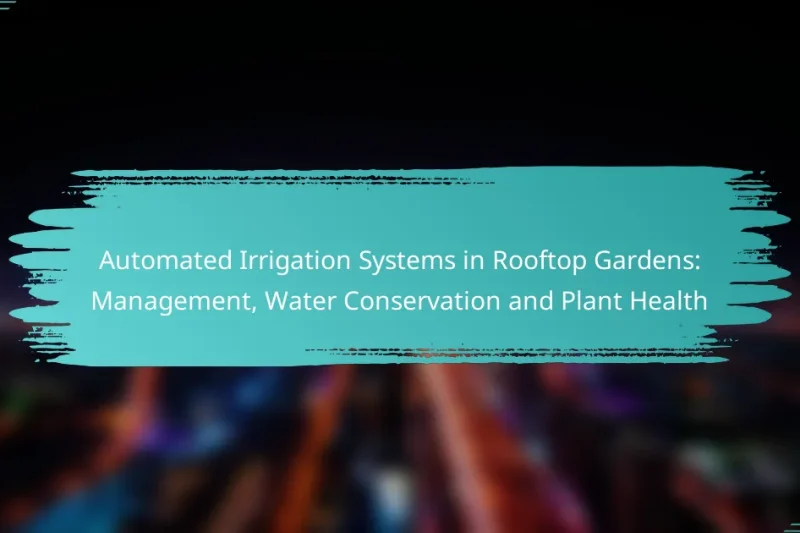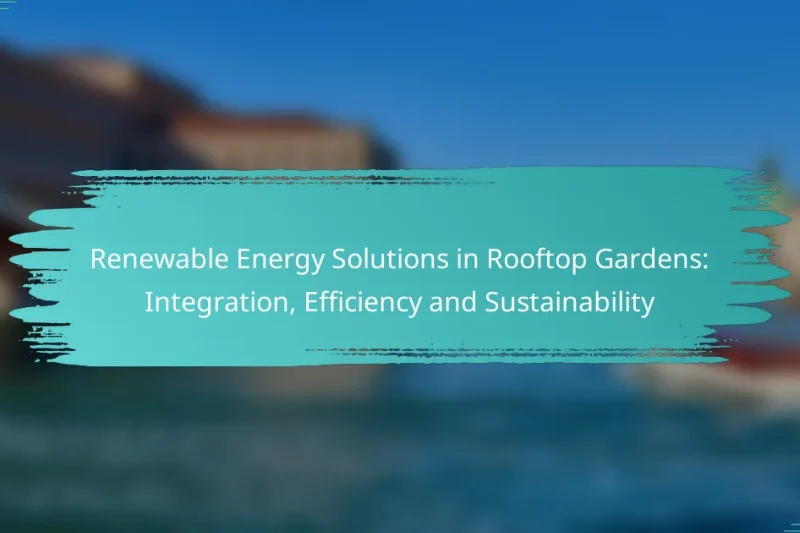Automated irrigation systems in rooftop gardens are essential for promoting efficient water use and enhancing plant … Automated Irrigation Systems in Rooftop Gardens: Management, Water Conservation and Plant HealthRead more
Rooftop Garden Technologies
Rooftop garden technologies are designed to enhance plant growth, optimize space, and promote sustainability in urban environments. By incorporating systems such as hydroponics, green roofing, and automated irrigation, these gardens not only improve air quality and energy efficiency but also contribute to effective stormwater management. Investing in these technologies can lead to healthier living conditions while addressing the challenges of urbanization.
Renewable Energy Solutions in Rooftop Gardens: Integration, Efficiency and Sustainability
Rooftop gardens represent a unique opportunity to integrate renewable energy solutions, enhancing urban sustainability through improved … Renewable Energy Solutions in Rooftop Gardens: Integration, Efficiency and SustainabilityRead more
What are the best rooftop garden technologies available?
The best rooftop garden technologies enhance plant growth, optimize space, and improve sustainability. Key options include hydroponic systems, green roofing systems, automated irrigation systems, vertical garden systems, and smart sensors for monitoring.
Hydroponic systems
Hydroponic systems grow plants without soil, using nutrient-rich water instead. This method can yield faster growth and higher productivity, making it ideal for urban rooftop gardens with limited space.
Consider systems like nutrient film technique (NFT) or deep water culture (DWC) based on your available space and budget. Hydroponics typically requires an initial investment of a few hundred to several thousand dollars, depending on the complexity of the setup.
Green roofing systems
Green roofing systems involve installing vegetation on rooftops to provide insulation, reduce stormwater runoff, and enhance biodiversity. They can be extensive (lightweight, low-maintenance plants) or intensive (heavier, more diverse plantings) based on your goals and structural capacity.
Before installation, check local regulations and building codes, as some areas may have specific requirements for green roofs. Costs can vary widely, from low hundreds to several thousand dollars per square meter, depending on the system’s complexity.
Automated irrigation systems
Automated irrigation systems deliver water efficiently to rooftop gardens, reducing water waste and ensuring plants receive the right amount of moisture. These systems can include drip irrigation or sprinkler systems, often controlled by timers or moisture sensors.
Investing in an automated system can save time and effort, especially for larger gardens. Look for systems that allow for customization based on plant needs and local climate conditions.
Vertical garden systems
Vertical garden systems maximize space by allowing plants to grow upwards on walls or trellises. These systems can be modular, using pockets or panels filled with soil or growing media, making them suitable for various plant types.
When choosing a vertical garden system, consider factors like sunlight exposure and plant compatibility. Costs can range from affordable DIY options to more expensive pre-made kits, depending on materials and design.
Smart sensors for monitoring
Smart sensors for monitoring provide real-time data on environmental conditions, such as soil moisture, temperature, and light levels. These devices help gardeners make informed decisions about watering and plant care, improving overall garden health.
Look for sensors that connect to mobile apps for easy monitoring and alerts. Prices vary, but basic sensors can start around $20, while more advanced systems may cost over $100.
How do rooftop gardens benefit urban environments?
Rooftop gardens provide multiple benefits to urban environments, including improved air quality, enhanced energy efficiency, and effective stormwater management. These green spaces contribute to healthier living conditions and can help mitigate some of the challenges posed by urbanization.
Improved air quality
Rooftop gardens help improve air quality by absorbing pollutants and carbon dioxide while releasing oxygen. Plants filter harmful particles from the air, which can significantly reduce urban smog and enhance overall air cleanliness.
Incorporating a variety of plants can maximize these benefits, as different species absorb different types of pollutants. For instance, native plants are often more effective in local climates and can thrive with less maintenance.
Energy efficiency
Rooftop gardens can enhance energy efficiency by providing insulation for buildings. They help regulate indoor temperatures, reducing the need for heating in winter and cooling in summer, which can lead to lower energy bills.
Studies suggest that green roofs can reduce energy consumption by up to 30% in some cases. Choosing the right plants and materials is essential for optimizing these energy-saving benefits.
Stormwater management
Rooftop gardens play a crucial role in stormwater management by absorbing rainwater, which helps reduce runoff and the risk of flooding. This absorption can prevent overloading of urban drainage systems during heavy rainfall.
Implementing a green roof can retain a significant portion of rainfall, often between 50% to 90%, depending on the design and plant selection. It is important to consider local regulations regarding stormwater management when planning a rooftop garden.
What are the costs associated with rooftop garden technologies?
The costs associated with rooftop garden technologies can vary significantly based on factors such as location, design complexity, and materials used. Generally, these costs can be divided into initial installation costs, ongoing maintenance expenses, and potential returns on investment from energy savings.
Initial installation costs
Initial installation costs for rooftop gardens typically range from several thousand to tens of thousands of dollars, depending on the size and type of garden. Factors influencing these costs include structural assessments, waterproofing, soil depth, and plant selection. Engaging a professional landscape architect can help ensure proper design and compliance with local regulations, which may also impact costs.
For instance, a basic extensive green roof may cost around $50 to $100 per square meter, while a more complex intensive green roof could range from $150 to $300 per square meter. Budgeting for these variations is crucial for accurate financial planning.
Maintenance expenses
Maintenance expenses for rooftop gardens can vary based on the garden type and local climate. Generally, ongoing costs may include irrigation, fertilization, pest control, and plant replacement. For extensive green roofs, maintenance might average around $1 to $3 per square meter annually, while intensive gardens could require $5 to $10 per square meter.
Regular inspections are essential to identify issues early and prevent costly repairs. Engaging a local landscaping service familiar with rooftop gardens can help manage these tasks effectively and ensure the garden remains healthy and vibrant.
Potential ROI from energy savings
Investing in rooftop gardens can lead to significant energy savings, contributing to a positive return on investment (ROI). By providing insulation, these gardens can reduce heating and cooling costs by up to 30%, depending on the building’s design and climate. This reduction can translate into hundreds or even thousands of dollars in savings annually.
Additionally, some regions offer tax incentives or grants for green building practices, further enhancing the financial benefits. Evaluating local programs can help maximize ROI while contributing to sustainable urban development.
What factors should be considered when choosing rooftop garden technologies?
When selecting rooftop garden technologies, consider the building’s structural integrity, local climate, and the types of plants you wish to cultivate. These factors influence the design, materials, and maintenance requirements of your rooftop garden.
Building structure and weight capacity
The building’s structure must support the additional weight of a rooftop garden, including soil, plants, and water. It’s crucial to consult with a structural engineer to assess the load-bearing capacity and ensure compliance with local building codes.
Typically, a rooftop garden can weigh anywhere from 15 to 100 kg per square meter depending on the design. Lightweight materials, such as modular planting systems, can help reduce weight while still providing a lush green space.
Climate and weather conditions
Understanding the local climate is vital for selecting appropriate rooftop garden technologies. Factors such as temperature fluctuations, wind exposure, and rainfall patterns will dictate the types of plants that can thrive and the irrigation systems needed.
For instance, in regions with high temperatures and low rainfall, consider installing a drip irrigation system to conserve water. Conversely, in wetter climates, ensure proper drainage to prevent waterlogging and root rot.
Plant selection and biodiversity
Choosing the right plants is essential for a successful rooftop garden. Select species that are well-suited to your climate and can tolerate the unique conditions of a rooftop environment, such as wind and limited soil depth.
Incorporating a diverse range of plants can enhance biodiversity and create a more resilient ecosystem. Consider native plants, which often require less maintenance and are better adapted to local conditions, as well as edible varieties for added functionality.
How can rooftop garden technologies be integrated into existing buildings?
Rooftop garden technologies can be integrated into existing buildings through careful planning and design modifications. This process typically involves assessing structural capacity, selecting appropriate garden systems, and ensuring compliance with local regulations.
Retrofitting options
Retrofitting options for rooftop gardens include modular green roofs, container gardens, and extensive green roof systems. Modular systems are often easier to install and can be added incrementally, while extensive systems require a more comprehensive structural assessment. Each option varies in terms of weight, maintenance needs, and plant selection.
For example, a modular green roof can weigh around 50-100 kg per square meter when fully saturated, making it suitable for many existing structures. In contrast, extensive green roofs may require additional structural support due to their heavier soil profiles.
Design considerations
Design considerations for rooftop gardens include sunlight exposure, wind patterns, and drainage solutions. It’s essential to choose plants that thrive in the specific climate and conditions of the rooftop. Additionally, incorporating features like irrigation systems and seating areas can enhance usability.
Consideration of weight distribution is crucial; ensure that the building’s roof can support the added load of soil and plants. A landscape architect can help optimize the design for aesthetics and functionality.
Local regulations and permits
Local regulations and permits play a significant role in the integration of rooftop garden technologies. Many municipalities require permits for structural modifications, especially if the rooftop garden alters the building’s height or drainage patterns. It’s important to check with local zoning laws and building codes.
In some regions, incentives may be available for green roofs, such as tax credits or grants. Engaging with local authorities early in the planning process can help streamline approvals and ensure compliance with environmental standards.
What are the latest trends in rooftop garden technologies?
The latest trends in rooftop garden technologies focus on sustainability, efficiency, and innovation. Key developments include advanced irrigation systems, modular planting solutions, and the integration of smart technology for monitoring and maintenance.
Smart Irrigation Systems
Smart irrigation systems utilize sensors and weather data to optimize water usage in rooftop gardens. These systems can significantly reduce water waste by adjusting watering schedules based on real-time conditions.
For example, a smart system might use soil moisture sensors to determine when plants need watering, ensuring that they receive just the right amount. This technology can lead to water savings of up to 50% compared to traditional irrigation methods.
Modular Green Roof Systems
Modular green roof systems consist of pre-planted trays or modules that can be easily installed and replaced. This approach simplifies the installation process and allows for greater flexibility in design and plant selection.
These systems often feature lightweight materials, making them suitable for various building types. They can be customized to include a variety of plants, from succulents to flowering species, enhancing biodiversity and aesthetic appeal.
Vertical Gardening Solutions
Vertical gardening solutions maximize space by allowing plants to grow upwards rather than outwards. This trend is particularly beneficial for urban environments where ground space is limited.
Using trellises, wall-mounted planters, or vertical hydroponic systems, gardeners can cultivate a diverse range of plants. This method not only increases the amount of greenery but also improves air quality and provides insulation for buildings.
Integration of Renewable Energy
Many rooftop gardens are now incorporating renewable energy sources, such as solar panels, to power irrigation systems and lighting. This integration enhances sustainability and reduces reliance on external power sources.
For instance, solar panels can provide energy for water pumps, making the garden more self-sufficient. This trend aligns with broader efforts to promote eco-friendly practices in urban landscaping.

